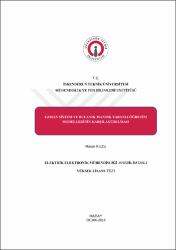| dc.contributor.advisor | Özdemir, Ersin | |
| dc.contributor.author | Kuzu, Hasan | |
| dc.date.accessioned | 2019-07-11T12:27:58Z | |
| dc.date.available | 2019-07-11T12:27:58Z | |
| dc.date.issued | 2018 | en_US |
| dc.date.submitted | 2018 | |
| dc.identifier.citation | Kuzu, H. (2018). Uzman sistem ve bulanık mantık tabanlı öğretim modellerinin karşılaştırılması (Yüksek Lisans Tezi). İskenderun Teknik Üniversitesi / Mühendislik ve Fen Bilimleri Enstitüsü, Hatay. | en_US |
| dc.identifier.uri | https://hdl.handle.net/20.500.12508/410 | |
| dc.description.abstract | Günümüzde artan bilgi ve öğrenme ihtiyacının karşılanmasında, geleneksel yöntemler yetersiz kalmaktadır. M.Ö 535-475 yılları arasında Efes'te yaşamış olan filozof Herakleitos "Değişmeyen tek şey değişimin kendisidir" demiştir. Bilgi teknolojilerindeki gelişmelere paralel olarak, eğitim-öğretimde de akıllı öğretme sistemlerinin kullanıldığı birçok uygulama geliştirilmektedir. Akıllı öğretim sistemleri öğrenci odaklı olduğundan, öğrencinin bireysel olarak değerlendirilmesine imkân sağlar. Bu çalışmada, her bir öğrencinin yeterliliğinin ve öğrenme seviyesinin farklı olması fikrinden yola çıkarak, ilköğretimden yükseköğretime kadar eğitimin tüm aşamalarında kullanılabilecek bir yazılım geliştirilmiştir. Bu yazılımda yapay zekâ metotlarından, Uzman Sistem ve Bulanık Mantık teknikleri ayrı ayrı kullanılarak, her öğrencinin öğrenme süreci bireysel olarak değerlendirilmektedir. Öğrencilerin yetersiz olduğu problemli konular belirlenmekte ve bu konularda öğrencilere destek eğitimi verilmesi amaçlanmaktadır. Bu sistemde öğretmen modülü, öğrenci modülü ve sınıf modülü bulunmaktadır. Sistemde bir veri tabanı oluşturulmuştur. Bu veri tabanında öğrenciler, verilecek dersler, derslere ait konular, ders videoları ve öğrencinin ilgili konuyu kavrama seviyesinin ölçüldüğü değerlendirme sınavları bulunmaktadır. Geliştirilen Uzman Sistem yazılımı ve Bulanık mantık yöntemi ayrı ayrı test edilerek öğrencilerin başarı durumları değerlendirilmiştir. Hangi konularda, ne kadar, ders desteği verileceği belirlenmektedir. Ders desteği, veri tabanında bulunan derslere ait videolar ile sağlanmaktadır. Sistem her öğrenci için kişisel yetenekleri ve öğrenme düzeyleri doğrultusunda farklı öneriler üretebilmektedir. Her iki algoritmanın önerileri, destek eğitimine harcanacak toplam süre açısından karşılaştırılmıştır. Yapılan deneylerde Bulanık Mantık yöntemi yaklaşık %9 daha az zaman ile eksik tamamlama eğitimi önermiştir. Bu sistemde, öğrencinin kişisel düzeyine göre özel eğitim verilebilmekte, her öğrenciye ayrılan zaman artmakta ve eğitim öğretim maliyetleri düşmektedir. Öğretmenin rolü, ders tekrar eden değil, öğrencinin bilgi ihtiyaçlarına göre derse yön veren ders yöneticisi konumuna taşınmıştır. | en_US |
| dc.description.abstract | In meeting the today's information and learning needs, traditional education methods are inadequate. The philosopher Heraclitus who lived in Ephesus between 535-475 BC said "The only thing that does not change is the change itself". Parallel to the developments in information technology, many applications are being developed in which intelligent teaching systems are used in education. Since intelligent teaching systems are student-centered, they allow the student to be evaluated individually. In this study, a software was developed that can be used at all stages of education from primary education to higher education, based on the idea that the sufficiency and learning level of each student are different. In this software, the learning processes of each student are evaluated individually by using Expert system and Fuzzy Logic techniques from artificial intelligence methods separately. Problematic issues that students are inadequate are determined and it is aimed to provide support education for students in these subjects. In this system, there are teacher, student and class modules. A database was created in the system. This database contains students, lectures to be given, lecture topics, course videos and evaluation exams measuring the students' comprehending levels on the related subjects. The developed Expert System software and fuzzy logic method were tested separately to evaluate the success status of the students. It is determined how much the course support will be given in which subjects. Course support is provided by the course videos in the database. The system is able to produce different suggestions for each student in the direction of their personal abilities and learning levels. The recommendations of both algorithms were compared in terms of the total time to be spent on support education. In the conducted experiments, the Fuzzy Logic method has suggested a fulfilment education with approximately 9% less time. In this system, special education can be provided according to the individual level of the student, the time assigned for each student increases and the costs of education and training decrease. The role of the teacher has been moved to the role of course manager guiding the class according to the information needs of the student, rather than repeating the course. | en_US |
| dc.language.iso | tur | en_US |
| dc.publisher | İskenderun Teknik Üniversitesi / Mühendislik ve Fen Bilimleri Enstitüsü / Elektrik-Elektronik Mühendisliği Anabilim Dalı | en_US |
| dc.rights | info:eu-repo/semantics/openAccess | en_US |
| dc.subject | Bilgisayar destekli eğitim | en_US |
| dc.subject | Akıllı öğretme sistemi | en_US |
| dc.subject | Uzman sistem | en_US |
| dc.subject | Yapay zekâ | en_US |
| dc.subject | Bulanık mantık | en_US |
| dc.subject | Computer aided education | en_US |
| dc.subject | Artificial intelligence | en_US |
| dc.subject | Intelligent teaching system | en_US |
| dc.subject | Expert system | en_US |
| dc.subject | Fuzzy logic | en_US |
| dc.title | Uzman sistem ve bulanık mantık tabanlı öğretim modellerinin karşılaştırılması | en_US |
| dc.title.alternative | Comparison of teaching models using expert system and fuzzy logic based methods | en_US |
| dc.type | masterThesis | en_US |
| dc.contributor.department | Dörtyol Meslek Yüksekokulu | en_US |
| dc.relation.publicationcategory | Tez | en_US |
| dc.contributor.isteauthor | Özdemir, Ersin | |
| dc.contributor.isteauthor | Kuzu, Hasan | |
| dc.relation.index | İndeks Bilgisi Yok | en_US |
















